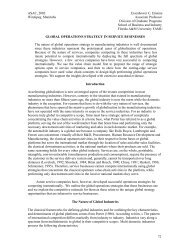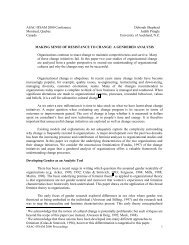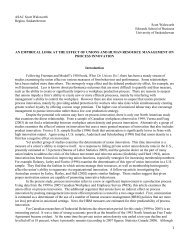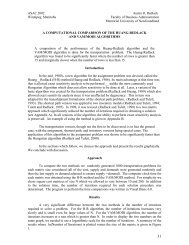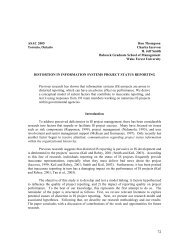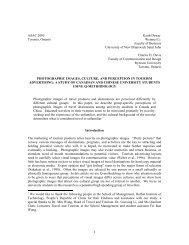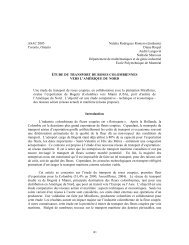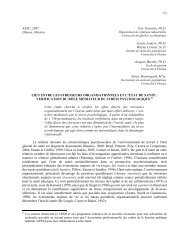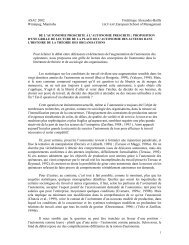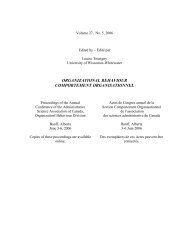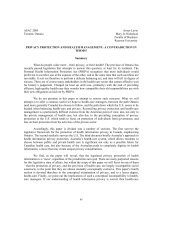Morrison, 1994). Future research that explores the moderating role of commitment onpsychological contract violations is needed, as is work that examines the causal links betweenaffective/normative commitment and psychological contracts.It was expected that respondents with high levels of continuance commitment (i.e., whenindividual-organizational attachment is grounded in cost-benefit analysis and the perceivedavailability of alternative employment options) would be more likely to hold shorter-term,narrowly-focused transactional obligations, and less likely to have relational obligations thanwould respondents who reported low levels of continuance commitment. Instead, we found thatcontinuance commitment correlated positively with elements of transactional and relationalcontracts. We found that respondents reporting high levels of continuance commitment held anarrow view of the job in terms of performance obligations (e.g., only perform duties for which Iam compensated; one perform specific duties I agreed to do when hired), but valued a longertermemployment relationship (e.g., no plans to look for a job elsewhere; feel an obligation toremain with this department indefinitely). This finding may help explain why employees whoreport high levels of continuance commitment, on average, are rated as less productive than thoseemployees who have low levels of continuance commitment or when the level of affectivecommitment is high (see Meyer & Herscovitch, 2001; Meyer et al., 2002). Organizations whoattempt to lock in their employees through non-portable pension plans, generous compensationpackages, or provide extensive training in organization-specific skills may, in fact, be fosteringcontinuance commitment and unintentionally encouraging the development of transactionalobligations. Future work is needed to examine further the links between continuancecommitment and perceived obligations, and the conditions that strengthen these relations.As with prior work showing links between turnover intention and both organizationalcommitment (e.g., Tett & Meyer, 1993) and psychological contract (e.g., Turnley & Feldman,1999), our findings explicitly link perceptions of individual-organizational attachment to microlevelmotivational process variables across several criterion domains. When the criterion is taskperformance, perceived norms have been shown to impact other cognitive mechanisms such asself-efficacy strength, performance valence, and personal goals or behavioral intentions (seeLocke & Latham, 1990). Moreover, when the criterion is absenteeism, perceived norms havebeen linked clearly to attendance motivation and absence culture (Johns, 1997). Establishing thatthe cognitive-motivational processes that mediate goal-setting activities are influenced byattitudinal dispositions opens up new research directions. We need to also think carefully aboutthe causal relationship between work attitudes and the social context. It is also quite plausiblethat the nature of our respondents’ commitment to their organization and their interpretation oftheir employment relationship via the psychological contract, including perceptions of fair socialexchange, is shaped by social information in the work environment (for a discussion of socialinformation processing theory and the implications of this model for work attitudes, see Salancikand Pfeffer, 1978). More work is clearly needed!One of the limitations of this study is the fact that all measures were self-report, raisingconcerns the relationships we observed resulted from common method variance. Lindell and hiscolleagues (Lindell & Brandt, 2000; Lindell & Whitney, 2001) have argued that researchers maybe able to assess the extent to which common method variance is a problem by including at leastone scale that is theoretically unrelated to at least one other scale in the questionnaire, so that onemay have a priori justification for predicting a zero correlation. A recent meta-analysis (Meyer etal., 2002) of the three-component model of organizational commitment suggests that thecorrelation between affective and continuance commitment across a large number of studies150
approaches zero. In the present study we observed a non-significant correlation betweencontinuance commitment and affective commitment factors (r=.07). Thus, we have little reason tobelieve that common method variance was a serious problem in our study. Other limitationsinclude the use of single-item measures and cross-sectional design. Future work is needed toexplore temporal relations among these concepts (cf. Rhoades et al., 2001).ReferencesAllen, N.J., & Meyer, J.P. (1996). Affective, continuance, and normative commitment to theorganization: An examination of construct validity. Journal of Vocational Behavior, 49,252-276.Anderson, N. & Schalk, R. (1998). The psychological contract in retrospect and prospect.Journal of <strong>Organizational</strong> Behavior, 19, 637-647.Arygris. C. (1962). Understanding organizational behavior, Dorsey: Homewood, Ill.Barrick, M.R., Mount, M.K., & Straus, J.P. (1993). Conscientiousness and performance of salesrepresentatives: Test of the mediating effects of goal setting. Journal of AppliedPsychology, 78, 715-722.Bentler, P.M. (1990). Comparative fit indices in structural models. Psychological Bulletin, 107,238-246.Bentler, P.M. & Bonett, D.G. (1980). Significance tests and goodness of fit in the analysis ofcovariance structures. Psychological Bulletin, 88, 588-606.Bollen, K.A. (1989). Structural equations with latent variables. New York: Wiley.Borman, W.C., & Motowidlo, S.J. (1993). Expanding the criterion domain to include elements ofcontextual performance. In N. Schmitt & W.C. Borman (Eds.), Personnel selection inorganizations (pp. 71-98). San Francisco: Jossey-Bass.Colarelli, S.M. (1984). Methods of communication and mediating processes in realistic jobpreviews. Journal of Applied Psychology, 69, 633-642.Cropanzano, R. & Greenberg, J. (1997). Progress in organizational justice: Tunneling throughthe maze. International Review of Industrial and <strong>Organizational</strong> Psychology, 12, 317-372.Eisenberger, R., Huntington, R., Hutchinson, S., & Sowa, D. (1986). Perceived organizationalsupport. Journal of Applied Psychology, 71, 500-507.Feldman, D.C. (1984). The development and enforcement of group norms. Academy ofManagement Review, 9, 47-53.Gellatly, I.R. (1996). Conscientiousness and task performance: Test of a cognitive processmodel. Journal of Applied Psychology, 81, 474-482.Gellatly, I.R., & Luchak, A.A. (1998). Personal and organizational determinants of perceivedabsence norms. Human Relations, 51, 1085-1102.Goffin, R.D., Gellatly, I.R., Paunonen, S.V., Jackson, D.N., & Meyer, J.P. (1996). Criterionvalidation of two approaches to performance appraisal: The behavioral observation scaleand the relative percentile method. Journal of Business and Psychology, 11, 23-33.Greenberg, J. (1990. <strong>Organizational</strong> justice: Yesterday, today and tomorrow. Journal ofManagement, 16, 399-432.Guest, D.E. (1998a). Is the psychological contract worth taking seriously? Journal of<strong>Organizational</strong> Behavior, 19, 649-664.Guest, D.E. (1998b). On meaning, metaphor and the psychological contract: A response toRousseau. Journal of <strong>Organizational</strong> Behavior, 19, 673-677.Hackman, J.R. (1992). Group influences on individuals in organizations. In M. Dunnette and L.151
- Page 1 and 2:
Volume 24, No. 5, 2003Edited by/Éd
- Page 4 and 5:
Pursey HeugensGreg IrvingRoderick I
- Page 6 and 7:
TABLE OF CONTENTS - TABLE DES MATI
- Page 8 and 9:
study of power displays in mixed-ge
- Page 10 and 11:
on expectations and behaviour (Berg
- Page 12 and 13:
TaskThis study required the use of
- Page 14 and 15:
Task-Gender (male-stereotyped or fe
- Page 16 and 17:
It is important to understand the s
- Page 18 and 19:
Crown, C.L. & Cummins, D.A. (1998).
- Page 20 and 21:
Smith-Lovin, L., & Brody, C. (1989)
- Page 22 and 23:
Table 2Summary of Descriptive Stati
- Page 24 and 25:
Table 4Summary of Interaction of Ge
- Page 26 and 27:
ASAC 2003Halifax, Nova ScotiaIain L
- Page 28 and 29:
the interrelationships among the MB
- Page 30 and 31:
studies (Friedman and Sarros, 1989;
- Page 32 and 33:
This study demonstrated that emotio
- Page 34 and 35:
Anxiety, Stress and Coping, in pres
- Page 36 and 37:
Washington, DC: Taylor and Francis,
- Page 38 and 39:
Table 2Overall Goodness-of-Fit Indi
- Page 40 and 41:
ζ 3Depersonalizationη 3β 3,1 (+)
- Page 42 and 43:
ASAC 2003Halifax, Nova ScotiaWendy
- Page 44 and 45:
views independently, gave rise to S
- Page 46 and 47:
track assistant, associate, and ful
- Page 48 and 49:
ole conflict are positively related
- Page 50 and 51:
Table 3. Regression of climate and
- Page 52 and 53:
interests.We speculate the null eff
- Page 54 and 55:
DOOP and short for DOOP scales,”
- Page 56 and 57:
Pelled, L. H., “Demographic diver
- Page 58 and 59:
esulting increase in discretion ove
- Page 60 and 61:
al., 1995). However, the distinctio
- Page 62 and 63:
ise to strong pressures for conform
- Page 64 and 65:
presented with a complete list of a
- Page 66 and 67:
Table 3QAP Regression Coefficients
- Page 68 and 69:
ConclusionResearchers of social inf
- Page 70 and 71:
suggestions for further research.
- Page 72 and 73:
performing on the job.” Presumabl
- Page 74 and 75:
positively related to performance i
- Page 76 and 77:
proposed hypotheses were supported.
- Page 78 and 79:
ConclusionThis research has made se
- Page 80 and 81:
Be more enthusiastic and exert extr
- Page 82 and 83:
Table 2Correlations Among the Laten
- Page 84 and 85:
performance expectations on feedbac
- Page 86 and 87:
changements qui s’opèrent dans l
- Page 88 and 89:
structures, politiques, systèmes,
- Page 90 and 91:
comportements liés à la communica
- Page 92 and 93:
Tableau 2Échelles de mesure de la
- Page 94 and 95:
prédiction des compétences clés
- Page 96 and 97:
organisation n’est pas uniforme e
- Page 98 and 99:
complètement ce construit. Ces cha
- Page 100 and 101:
Wagner, R.K. and Sternberg, R.J. (1
- Page 102 and 103:
What is a toxin handler?In two arti
- Page 104 and 105:
potentially limited scope and conte
- Page 106 and 107: work role demands. In this survey,
- Page 108 and 109: The three factors in this rotated f
- Page 110 and 111: and service orientation, the abilit
- Page 112 and 113: ASAC 2003Halifax, Nova ScotiaLisa M
- Page 114 and 115: self-appraisal group reacted more n
- Page 116 and 117: effect of voice are the value-expre
- Page 118 and 119: “Strongly Disagree” to “Stron
- Page 120 and 121: esults suggest that incorporating s
- Page 122 and 123: Personality and Social Psychology,
- Page 124 and 125: Table 1Means, Standard Deviations,
- Page 126 and 127: Table 3Test of the Mediating Role o
- Page 128 and 129: ASAC 2003Halifax, Nova ScotiaAnn Fr
- Page 130 and 131: individual level, polychronicity is
- Page 132 and 133: construct.Drawing on computer-media
- Page 134 and 135: Consequence: Impact on Work Overloa
- Page 136 and 137: Conversation complexity may also mo
- Page 138: Implications for practiceFuture res
- Page 141 and 142: ReferencesAncona, D.G., Goodman, P.
- Page 143 and 144: no. 3 (1994): 381-391.Macan, T.H.,
- Page 145 and 146: ASAC 2003Halifax, Nova ScotiaIan R.
- Page 147 and 148: Assessing Measures: Affective Commi
- Page 149 and 150: implications of psychological contr
- Page 151 and 152: commitment, affective commitment, c
- Page 153 and 154: Motivational Process Variables. Amo
- Page 155: DiscussionThe main purpose of this
- Page 159 and 160: Extension and test of a three-compo
- Page 162 and 163: Table 1Descriptive Statistics and Z
- Page 164 and 165: Table 3Standardized Factor Loadings
- Page 166 and 167: Table 5Hierarchical Regression Anal
- Page 168 and 169: ASAC 2003Halifax, Nova ScotiaJoan F
- Page 170 and 171: ASAC 2003Halifax, Nova ScotiaArla D
- Page 172 and 173: ASAC 2003Halifax, Nova ScotiaIvy Ky
- Page 174: ASAC 2003Halifax, Nova ScotiaNina D



